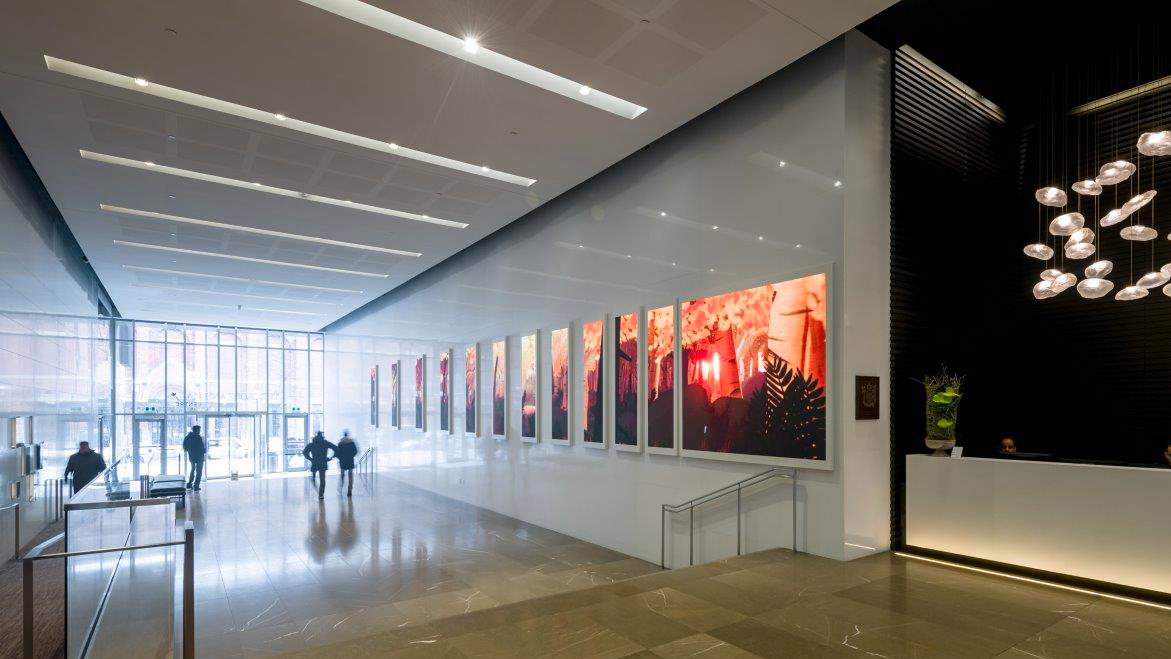Creating Calm
The Globe and Mail Centre is a 17-story, mixed-use office building in Toronto’s King East Design District and houses Canada’s Globe and Mail newspaper, in addition to other tenants.
In 2019, First Gulf engaged multidisciplinary design firm Forge Media + Design to create a digital art installation that would enliven the building lobby and enhance the tenant and visitor experience. First Gulf desired an installation that would reflect the commercial developer’s core principles in building sustainable, tenant-friendly projects that offer healthy work environments. One of the characteristics of First Gulf’s buildings is a substantial amount of space dedicated to outdoor areas and terraces.
“Bloom” presents an idyllic hand-illustrated forest-scape that emphasizes the effect that nature has on humanity and the reverence that we should hold for maintaining a balance between wildlife and urban sprawl. The art piece features 72 different scenes set in three different biomes and includes seasonal changes, varying flora, floating lanterns, spirit animals, and shifting light that emulates the time of day.
The concept of growth is also suggested in the actual physical arrangement of the installation. Closer to the center of the lobby, one end of the installation is marked by the larger Planar TVF Series LED video wall in a 4x6 configuration. Moving from that LED column to the other end of the overall display, the spacing between LED video walls becomes larger and larger—growing outward.
Roman Brailovski, First Gulf vice president of property management and operations, said the artwork captures the history of the site, the uniqueness of the architecture, and the core character of his company. “Forge animated the entire wall and created a remarkable product,” he said. “There is a sense of eternal continuity within this piece of art.”
The sheer scale and nature of the array of columns suited the use of LEDs, according to Roberts. “LED was the clear choice: bezels would have interrupted the powerful imagery that we worked so hard to develop,” he said. “The Planar TVF Series LED displays were easy to install and the fact that the system is modular and the cabinets are stackable, without the need for extra cabling, is a great advantage—saving time and resources during the installation.”
In Their Own Words
We asked executives from leading manufacturers to share their insights on digital signage applications for today and the future.
Aurora
Aurora Multimedia recently introduced an advanced temperature-sensing tab-let, the TAVIS (Thermal AV Integrated Solution). Made in the USA, the fully integrated system supports contactless interviews through gesture controlled answers, customized digital signage/messaging, and serves as the basis for future development. Additionally, QR codes are recognized by TAVIS for contactless identification during the screening process.

Aurora’s ReAX control engine is the backbone force that delivers a powerful open control platform—allowing flexibility with a fully customizable interface. Contactless system control can be initiated by scanning a QR code generated by ReAX. This initiation allows a mobile phone-based control environment driven by the ReAX engine.
Aurora is working to stay on the forefront of audio and visual sensing technology. From its dual cameras that eye-track, to expression monitoring, to database logging of interactions, it is pushing the boundaries of what’s possible with health and safety technology. Aurora is driven to provide a safe environment—offering technology to pave the way to reopening offices worldwide.
Barco
Prior to COVID, lobby videowalls were about branding and messaging. But now they are also important and initial touchpoints for safety protocol as well as corporate reassurance. Similarly, experience centers will see a shift to more videowall usage as virtual demos take precedence over in-person. Boardrooms will continue to be the venue of choice when customers, partners, and boards of directors can meet in person. There will be an expectation that these boardrooms offer the finest technology available as the place where the company’s image and promise is conveyed (like lobby walls but more collaborative). Again, the “wow” factor is of utmost importance, as you only have one chance to make a first impression.

Razor-narrow-bezel (RNB) LCD display and direct-view (DV) LED are the biggest stories in display technology. B2B customers have progressed toward technologies that minimize the bezel as much as possible (RNB) or eliminate it (DV LED), as it is seen as a distraction from the message and the ambiance of the environment.
High-res direct-view LED like the LED XT series is particularly at the growing stages of being a highly desirable videowall technology. The trouble is that the market is being flooded with the vestiges of outdoor LED manufacturers trying to quickly recognize sales, and this had added confusion to a market that is much more sophisticated and complex. LED is a professional technology that requires a professional approach and processing.
BrightSign
The pandemic changed the AV space by accelerating adoption of technologies that reduce or eliminate physical interaction with digital signage. At BrightSign, we developed a trio of new touchless solutions our customers are eagerly embracing: BrightLink, BrightMenu, and BrightVoice.
BrightLink is a new touchless solution that eliminates the need to physically engage with touch-interactive digital signage. By simply scanning a QR code, customers transfer control of the experience to their phones to browse or interact with content as they normally would—eliminating the need for physical contact.

BrightLink is a new touchless solution that eliminates the need to physically engage with touch-interactive digital signage. By simply scanning a QR code, customers transfer control of the experience to their phones to browse or interact with content as they normally would—eliminating the need for physical contact.
BrightMenu uses very similar BrightSign technology, but delivers a one-way experience whereby patrons scan a QR code and receive the restaurant’s menu on their mobile device—no internet connection, no app to download, and no printed menus.
BrightVoice is voice-activated digital signage solution that delivers a unique, hands-free interactive experience—allowing people to interact with displays by engaging in tailor-made conversations using a wake word followed by natural voice commands to control on-screen playback.
And beyond our BrightSign-labeled COVID products, we’re working closely with a number of other partners—providing the media player back-end to power solutions to help businesses safely reopen, while adhering to new health and safety guidelines.
To be clear, these solutions will be around long after the urgency of the pandemic begins to wane. Touchless solutions are convenient, elegant, and precisely the sort of customer interaction people need now, and in the future.
>> More on Digital Signage
- Privacy and Digital Signage
- Assembling the Digital Signage Puzzle
- Digital Signage Expo return for 2022
- Rise Vision Makes Digital Signage Easier and More Affordable With Support for New Media Players
- 22Miles Launches New Line of Ready-Built Digital Signage & Wayfinding Software Bundles
Navori
The COVID-19 pandemic has inspired businesses to leverage AI-based computer vision technology that can automate environments and support applications to effectively manage human traffic. Businesses and venues must ensure safety for employees and customers with clear, up-to-date instructions. This notably includes occupancy-monitoring applications that integrate with digital signage systems to streamline the flow of in-store foot traffic and limit the number of on-premise customers at any given time.

Navori Labs developed its new access control software to manage these requirements. Integrated within Navori’s QL Digital Signage Software suite, the module uses video streams to monitor and control occupancy at the entrance and exits via digital signage, for example. Multiple inputs and outputs are available for facilities with more than one entrance and exit, and the software interoperates with security cameras for live streaming and monitoring.
The software also can be associated with advanced applications such as temperature checks and detailed detection. The latter addresses specific identifying characteristics—from simply wearing face masks to the exact fabric type, color, and pat-tern. Integration with digital signage also preserves the customer a pleasant customer experience by entertaining visitors during what can be lengthy waiting times in the queue. Importantly, visitor privacy is assured, as the technology does not store, re-use, or disseminate personal data. Built-in AI instead applies silhouette detection (including the presence of face masks) instead of facial recognition.
The complementary role of digital signage with the video feed interpretation ensures a frictionless experience, while securing visitors and employees.
Samsung
Our portfolio of display solutions to meet the needs of customers during the pandemic has looked different across a variety of verticals. For example, some of our Pro TVs were integrated into hospitality settings to assist with wayfinding. This allows for customers to have a clear indicator of where their room may be without needing direct contact with someone at the front desk.

These same displays were also integrated into school systems to help teachers and students stay connected in the hybrid learning environment. Educators can connect with their students learning from home by displaying them on the Pro TV in the classroom. Teachers have shared that they have benefitted from this model, as they can still see and interact with remote students as if they were there in person. Another good example of our adaptable solutions is our Samsung Interactive Display, which can be integrated into education and corporate settings to increase collaboration within the office and classroom, and for those who are working from home. The display can be synced to connected devices through mirroring capabilities, and those from home can still make changes on the display in real time. This increases collaboration and connectivity, and the interactive display will continue to remain a staple in offices and classrooms beyond the pandemic. We anticipate that many of our customers will continue using our incredibly versatile solutions for a multitude of needs beyond the pandemic.
Sony
We are seeing more displays being added to learn-ing, working, and collaborative environments for increased interactivity and enhanced visibility. Sony’s versatile lineup of BRAVIA professional displays combines flexibility, connectivity, and ease of use with superior picture quality to support new ways of working and learning. BRAVIAs are being used as reference monitors and displays—situated throughout class- rooms and offices of the future to deliver engaging visuals and offer opportunities for collaboration. The new BRAVIA BZ40H series of 4K HDR professional displays comes in 55- to 85-inch sizes—offering viewers an immersive and detailed view of content from virtually any viewing location. The displays also feature a powerful SoC platform, Android-P OS, and mirroring with Apple AirPlay 2 and Chromecast, so users can feel confident, safe, and secure operating the display from their personal devices in a contactless and touch-free manner.

As the needs of customers transition to our changing world, BRAVIA displays are ready to flexibly adapt with them. Through software partnerships, Sony’s BRAVIAs can be tailored to add even more powerful features, based on the needs of customers. For example, iRevo software licenses offer cloud-based digital signage capabilities—enabling remote content and minimizing the need for personnel on site. The Logitech Collaboration Program confirms Sony’s 4K BRAVIA professional displays with the compatibility to be paired with Logitech Room Solutions for Zoom Rooms, Microsoft Teams, and Google Meet. This creates a simple, all-inclusive, plug-and-play video collaboration solution that is ideal for large groups—including students and colleagues—enabling an engaging and productive virtual or socially distant educational or working experience.
Visix
Visix reassessed our roadmap in March [2020] due to COVID-19, and we immediately shifted our software, creative, and production priorities. Our three primary goals were to help our clients with health and safety messaging, reducing germ transmission, and engaging remote audiences.
In April, we published over 200 free messages covering a variety of topics, such as COVID-19 safety and reopening, WFH productivity, videoconferencing and email tips, as well as motivational messages. Our clients have had more on their minds than creating visuals, so we wanted to give them helpful, engaging content they could use while they focused on adapting to the pandemic.

To address germ transmission, we released a Voice Recognizer Widget for our AxisTV Signage Suite software in May. This lets clients offer speech interaction instead of, or in addition to, touch interaction, and it works on any display—whether it’s touchscreen or not. Because it uses the built-in speech recognition engine for Windows 10 that’s in our media player, clients just add the widget to layouts and configure keywords. We expanded the Voice Recognizer to our interactive room signs a couple of months later, and added antimicrobial screen protectors that reduce germ transmission by up to 99 percent.
We recently released our HTML5 viewer that publishes message playlists in a web browser, and can be embedded in webpages and intranets to engage remote employees, students, and staff from a central source. We’re continuing to develop this feature, and plan to integrate with more apps and messengers in 2021.

